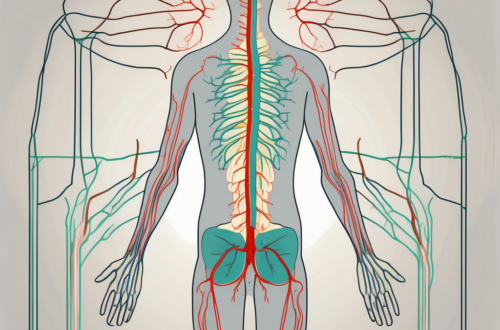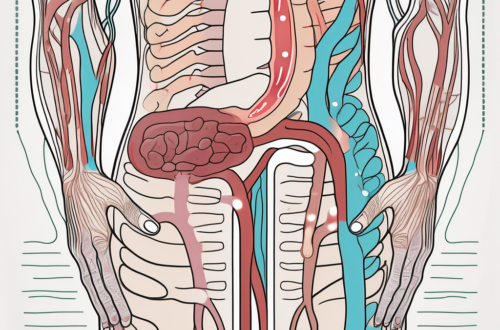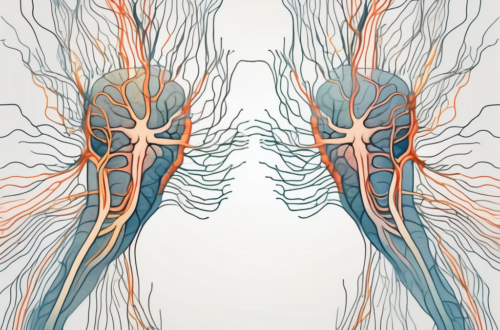In the world of pain management, the use of nerve blocks has become increasingly popular. Nerve blocks offer a targeted approach to alleviating pain by interrupting the signals between nerves and the brain. One type of nerve block that has garnered attention is the parasympathetic nerve block. If you’re considering this procedure, you may be wondering how long it takes for a parasympathetic nerve block to take effect. In this article, we will delve into the details of this treatment and provide insights into its effectiveness and time frame.
Understanding the Parasympathetic Nervous System
Before diving into the specifics of parasympathetic nerve blocks, let’s first explore the parasympathetic nervous system as a whole. The autonomic nervous system can be divided into two branches – the sympathetic and the parasympathetic. While the sympathetic nervous system is responsible for the “fight or flight” response, the parasympathetic nervous system is responsible for the body’s “rest and digest” functions. It controls activities such as digestion, urination, and sexual arousal.
When it comes to the parasympathetic nervous system, it is important to understand its role and function in maintaining overall well-being and homeostasis. This branch of the autonomic nervous system works in opposition to the sympathetic nervous system to maintain a balance in the body. Its primary role is to regulate various bodily functions, promoting relaxation and conserving energy.
The parasympathetic nervous system is a complex network of neural pathways that plays a crucial role in our daily lives. It is responsible for controlling activities such as digestion, urination, and sexual arousal. Without the parasympathetic nervous system, our bodies would not be able to properly digest food, eliminate waste, or experience sexual pleasure.
Role and Function of the Parasympathetic Nervous System
The parasympathetic nervous system works in opposition to the sympathetic nervous system to maintain a balance in the body. Its primary role is to regulate various bodily functions, promoting relaxation and conserving energy. This branch of the autonomic nervous system is crucial for overall well-being and homeostasis.
One of the key functions of the parasympathetic nervous system is to stimulate digestion. When we eat a meal, the parasympathetic nervous system kicks into gear, releasing digestive enzymes and increasing blood flow to the digestive organs. This allows our bodies to break down food and absorb nutrients efficiently.
In addition to its role in digestion, the parasympathetic nervous system also plays a vital role in controlling urination. When the bladder is full, the parasympathetic nervous system signals the muscles in the bladder to contract, allowing urine to be expelled from the body. Without this important function, we would not be able to eliminate waste properly.
Furthermore, the parasympathetic nervous system is involved in sexual arousal and reproduction. When we experience sexual stimulation, the parasympathetic nervous system triggers the release of nitric oxide, a chemical that relaxes blood vessels in the genital area and allows for increased blood flow. This leads to erection in males and increased sensitivity in females, enhancing sexual pleasure.
The Anatomy of the Parasympathetic Nervous System
The parasympathetic nervous system is complex and encompasses various neural pathways. It primarily originates from the cranial nerves and the sacral region of the spinal cord. The cranial nerves include the vagus nerve, which plays a vital role in controlling parasympathetic functions in the head, neck, thorax, and abdomen.
The vagus nerve is the longest cranial nerve and has branches that innervate various organs, including the heart, lungs, stomach, and intestines. It is responsible for regulating heart rate, controlling breathing, stimulating digestion, and promoting relaxation throughout the body.
In addition to the cranial nerves, the parasympathetic nervous system also includes the sacral region of the spinal cord. This region gives rise to the pelvic splanchnic nerves, which control parasympathetic functions in the pelvic organs, such as the bladder, reproductive organs, and lower gastrointestinal tract.
Understanding the intricate anatomy of the parasympathetic nervous system is essential for comprehending how nerve blocks can affect its functioning. By targeting specific neural pathways, nerve blocks can selectively block the transmission of parasympathetic signals, providing therapeutic benefits in certain medical conditions.
The Concept of Nerve Blocks
Now that we have a foundation in understanding the parasympathetic nervous system, let’s explore the broader concept of nerve blocks. A nerve block is a medical procedure where an anesthetic or a combination of anesthetics and other medications are injected near specific nerves to provide pain relief. The goal of a nerve block is to interrupt the pain signals transmitted by the nerves, thus reducing or eliminating pain in the affected area.
Nerve blocks have been used for centuries to manage pain. The concept of blocking nerve signals to alleviate pain can be traced back to ancient civilizations. In ancient Egypt, for example, papyrus scrolls dating back to 1550 BCE describe the use of opium-soaked bandages placed on the skin to numb pain. Over time, the techniques and medications used in nerve blocks have evolved, leading to more precise and effective pain management strategies.
What is a Nerve Block?
A nerve block involves the precise administration of medications near specific nerves to provide localized pain relief. These medications can include local anesthetics, steroids, and other agents that can modulate the transmission of pain signals. Nerve blocks can be used for various purposes, such as diagnostic purposes to identify the source of pain, therapeutic purposes to relieve chronic pain, or as a preemptive measure before surgical procedures.
When performing a nerve block, a healthcare professional will carefully identify the target nerve or nerves using imaging techniques, such as ultrasound or fluoroscopy. Once the target nerve is located, a needle is inserted near the nerve, and the medication is injected. The medication then spreads around the nerve, blocking the pain signals from reaching the brain.
One of the advantages of nerve blocks is their ability to provide targeted pain relief. Unlike oral medications, which can affect the entire body, nerve blocks specifically target the nerves responsible for transmitting pain signals. This targeted approach can result in more effective pain relief with fewer side effects.
Different Types of Nerve Blocks
There are numerous types of nerve blocks, each targeting a specific nerve or group of nerves. Some commonly used nerve blocks include epidural blocks, spinal blocks, and peripheral nerve blocks. When it comes to the parasympathetic nervous system, parasympathetic nerve blocks specifically target the nerves involved in regulating parasympathetic functions.
Epidural blocks, for example, are commonly used during childbirth to provide pain relief. In this procedure, medication is injected into the epidural space, which surrounds the spinal cord. This blocks the pain signals from reaching the brain, allowing the mother to have a more comfortable birthing experience.
Spinal blocks, on the other hand, involve injecting medication directly into the cerebrospinal fluid surrounding the spinal cord. This type of nerve block is often used for surgical procedures on the lower abdomen, pelvis, or legs. By blocking the nerves in the lower part of the body, spinal blocks can provide effective pain relief during and after surgery.
Peripheral nerve blocks target specific nerves outside the central nervous system. These blocks can be used to manage pain in various parts of the body, such as the arms, legs, or face. By blocking the pain signals at the source, peripheral nerve blocks can provide long-lasting pain relief without the need for systemic medications.
It’s important to note that nerve blocks are not without risks. Like any medical procedure, there is a potential for complications, such as infection, bleeding, or nerve damage. However, when performed by experienced healthcare professionals, the benefits of nerve blocks often outweigh the risks, providing patients with much-needed pain relief and improved quality of life.
The Process of a Parasympathetic Nerve Block
Preparing for a Parasympathetic Nerve Block
If you and your healthcare provider have determined that a parasympathetic nerve block may be a suitable treatment option for your pain, proper preparation is essential. Your doctor will provide you with specific instructions to follow leading up to the procedure. It is crucial to communicate any allergies, medications, or medical conditions you may have to ensure your safety and the effectiveness of the nerve block. Your doctor may also advise you to stop taking specific medications or alter your diet leading up to the procedure.
Preparing for a parasympathetic nerve block involves more than just following instructions. It is a time when you can ask questions and gain a deeper understanding of the procedure. Your healthcare provider will take the time to explain the purpose of the nerve block, how it works, and what you can expect during and after the procedure. This knowledge will help alleviate any anxiety or concerns you may have, allowing you to approach the nerve block with confidence.
Additionally, your doctor may recommend certain lifestyle changes or exercises to help prepare your body for the nerve block. These could include gentle stretching or relaxation techniques to help relax the muscles around the targeted nerves. By incorporating these practices into your routine, you can enhance the effectiveness of the nerve block and potentially reduce the amount of pain medication needed.
The Procedure of a Parasympathetic Nerve Block
A parasympathetic nerve block procedure typically takes place in a healthcare facility, such as a hospital or an outpatient clinic. The specific steps involved in the procedure may vary depending on the nerve block location and the purpose of the block. Before the procedure begins, you will likely be provided with information on what to expect and any potential side effects or risks associated with the nerve block. Your doctor will administer local anesthesia to numb the area and then use imaging techniques, such as fluoroscopy or ultrasound, to guide the insertion of a needle near the targeted nerves. Once the needle is in place, the medication will be injected, and you may experience some pressure or a brief sensation of warmth.
The use of imaging techniques during a parasympathetic nerve block is crucial for accurate needle placement. Fluoroscopy, a real-time X-ray, allows the doctor to visualize the needle’s position in relation to the nerves, ensuring precise delivery of the medication. Ultrasound, on the other hand, uses sound waves to create images of the targeted area, providing a detailed view of the nerves and surrounding structures. By combining these advanced imaging technologies with the expertise of your healthcare provider, the chances of a successful nerve block are significantly increased.
Once the medication is injected, it begins to work by blocking the parasympathetic nerves responsible for transmitting pain signals. This blockage interrupts the pain pathway, providing relief from chronic pain conditions. The duration of the nerve block’s effectiveness can vary from person to person, but it can last anywhere from a few hours to several months. Your doctor will discuss the expected duration and any potential side effects or complications associated with the specific nerve block you are receiving.
After the procedure, you may be monitored for a short period to ensure there are no immediate complications. Your doctor will provide you with post-procedure instructions, including any restrictions on activities or medications. It is essential to follow these instructions carefully to optimize the benefits of the nerve block and minimize any potential risks.
Time Frame for a Parasympathetic Nerve Block to Take Effect
Immediate Effects of a Parasympathetic Nerve Block
After the parasympathetic nerve block procedure, you may experience immediate pain relief in the targeted area. This relief is primarily attributed to the local anesthetic used during the procedure. The anesthetic temporarily blocks the transmission of pain signals, offering immediate relief from discomfort. It is important to note that the duration and extent of immediate pain relief can vary depending on several factors, including the type of nerve block administered and individual response.
Long-Term Effects of a Parasympathetic Nerve Block
While immediate pain relief can be beneficial, the long-term effects of a parasympathetic nerve block may take time to manifest. In some cases, a single nerve block may provide lasting relief. However, more often, a series of nerve blocks may be required to achieve sustained pain reduction. The cumulative effects of repeated nerve blocks can lead to more significant and long-lasting relief for some individuals. However, it is essential to keep in mind that the longevity of pain relief can vary from person to person, and regular follow-up appointments with your healthcare provider are essential to assess the effectiveness of the parasympathetic nerve block.
Factors Influencing the Effectiveness of a Parasympathetic Nerve Block
Patient Factors
Various patient-related factors can influence the effectiveness and duration of a parasympathetic nerve block. These can include individual pain tolerance, the presence of other medical conditions, and overall health status. Additionally, the underlying cause of the pain requiring the nerve block can also impact the results. It is essential to have a comprehensive discussion with your healthcare provider to determine if a parasympathetic nerve block is the right approach for your specific condition.
Medical Factors
In addition to patient factors, several medical considerations can impact the effectiveness of a parasympathetic nerve block. The choice of local anesthetic, the specific medications used, and the technique employed during the procedure can all affect the outcome. Additionally, the experience and expertise of your healthcare provider in performing parasympathetic nerve blocks play a crucial role in the success of the treatment. Consulting with a qualified healthcare professional specializing in pain management is imperative to ensure optimal outcomes.
Risks and Complications of a Parasympathetic Nerve Block
Common Risks Associated with Nerve Blocks
Like any medical procedure, parasympathetic nerve blocks come with some potential risks and complications. While rare, these can include infection, bleeding, nerve damage, and allergic reactions to the medications used during the procedure. It is crucial to discuss any concerns or pre-existing medical conditions with your healthcare provider to evaluate the potential risks and benefits of a parasympathetic nerve block in your specific case.
How to Manage Potential Complications
To minimize the risk of complications, it is crucial to work closely with your healthcare provider throughout the entire process. They will provide guidance on pre-procedure preparations, potential side effects, and any necessary post-procedure care. Following their instructions and promptly reporting any adverse reactions or complications will help ensure your safety and optimize the effectiveness of the nerve block.
Conclusion: The Importance of Understanding Nerve Blocks
The Role of Nerve Blocks in Pain Management
Nerve blocks, such as parasympathetic nerve blocks, can be valuable tools in managing pain. By targeting specific nerves and interrupting pain signals, nerve blocks offer a localized and effective approach to pain relief. However, it is essential to remember that nerve blocks are a medical procedure that requires expert evaluation and administration. Consulting with a qualified pain management specialist is crucial in determining if a nerve block is the appropriate treatment option for your specific condition.
Future Developments in Nerve Block Procedures
The field of pain management is continuously evolving, and advances in nerve block procedures are being made. Researchers and healthcare professionals are exploring innovative techniques, medications, and technologies to enhance the effectiveness and safety of nerve blocks. By staying informed and discussing your options with a knowledgeable healthcare provider, you can benefit from the advancements in this field.
In conclusion, the time frame for a parasympathetic nerve block to take effect can vary. Immediate relief from pain can often be experienced shortly after the procedure due to the local anesthetic used. However, sustained and significant pain reduction may take time and potentially require multiple nerve block treatments. The duration of pain relief can vary based on individual factors and the underlying cause of the pain. Collaborating with a healthcare provider experienced in nerve blocks is essential to determine if this intervention is suitable for you. By exploring the intricacies of parasympathetic nerve blocks, you are better equipped to make informed decisions regarding your pain management journey.




